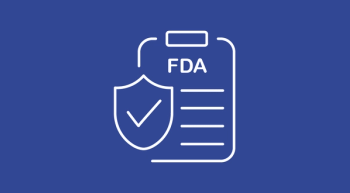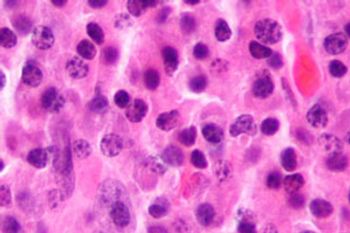
Liso-cel may be an effective treatment option for relapsed/refractory mantle cell lymphoma, including those with high-risk features who have limited treatment options.

Liso-cel may be an effective treatment option for relapsed/refractory mantle cell lymphoma, including those with high-risk features who have limited treatment options.

Two experts commented on ways oncology nurses can learn more about administering TIL therapy and how they can play a supportive role for patients receiving the treatment.

Lurbinectedin confers greater activity with a superior safety profile when compared with topotecan in a subset of patients with small cell lung cancer.

Oncology nurses can assist patients in understanding the significance of KRAS mutation testing and its treatment implications.

A supplemental Biologics License Application for teclistamab-cqyv (Tecvayli) has been approved by the FDA at a reduced dose of 1.5 mg/kg every 2 weeks for the treatment of patients with relapsed/refractory multiple myeloma who have maintained a complete response or greater for at least 6 months.

Wearable technology can track hand hygiene protocol adherence, making wards more aware of their hand washing and sanitizing rates on a weekly basis.

Treatment-emergent symptoms were easily resolved after treatment with olaparib for BRCA1/2 high-risk HER2-negative breast cancer, as shown in a patient reported outcome analysis of the phase 3 OlympiA trial.


Stereotactic ablative radiotherapy with standard-of-care therapy improved progression-free survival in patients with oligoprogressive non-small cell lung cancer, although the benefit was not seen in those with oligoprogressive breast cancer.

All prespecified patient subgroups with metastatic urothelial cancer showed a clinical benefit with sacituzumab govitecan plus pembrolizumab in cohort 3 of the phase 2 TROPHY-U-01 trial.

The first real-time, non-invasive skin cancer evaluation system has received clearance from the FDA.

The use of perioperative tislelizumab plus neoadjuvant chemotherapy has been supported by findings from the phase 3 RATIONALE-315 study as a treatment for resectable stage II to IIIA non–small cell lung cancer.

The FDA approved osimertinib for use with platinum-based chemotherapy to treat patients with locally advanced or metastatic non-small cell lung cancer that harbor EGFR exon 19 deletions or exon 21 L858R mutations.

Lifileucel is the first TIL therapy approved by the FDA for a solid tumor, specifically previously treated unresectable or metastatic melanoma.

A treatment for NTRK-positive locally advanced or metastatic solid tumors, repotrectinib, is currently under priority review by the FDA and may address a high unmet medical need.

The FDA granted an orphan drug designation to soquelitinib for potential use in T-cell lymphoma.

Tepotinib has received a traditional approval from the FDA for metastatic NSCLC with MET exon 14 skipping alterations, updating the previous accelerated approval from 2021.

Dawn Landolph, RN, BSN, OCN, MPA, provides an in-depth look at adagrasib for the treatment of patients with KRAS G12C-mutated, locally advanced or metastatic non-small cell lung cancer in a downloadable reference sheet.

Patients with recurrent ovarian cancer with BRCA-mutated and/or BRCAness phenotype did not derive a survival benefit with trabectedin when compared with chemotherapy.

Although breast cancer has historically been associated with female patients, the rates of men with breast cancer have been increasing over the past decade.

The NCCN has published its first set of treatment recommendations patients with for neuroblastoma.

Irinotecan liposome has been approved by the FDA for use with oxaliplatin, leucovorin, and fluorouracil to treat patients with metastatic pancreatic adenocarcinoma.

Virtual reality headsets can be used to reduce anxiety in patients with cancer undergoing treatment and as an educational tool for nurses learning how to have difficult conversations with patients.

Bispecific antibodies that engage T cells are an effective treatment modality in relapsed/refractory disease and are an important new treatment for relapsed large B-cell lymphoma.

Patients with castration-sensitive prostate cancer treated with apalutamide plus androgen deprivation therapy experienced improvements in prostate-specific antigen progression-free survival.

Patients with stage III epithelial ovarian cancer treated with hyperthermic intraperitoneal chemotherapy plus interval cytoreductive surgery had improved progression-free survival and overall survival.

Fast track designation has been granted by the FDA to vepdegestrant for the treatment of select patients with ER-positive/HER2-negative locally advanced or metastatic breast cancer.

Difficult conversations in cancer pain management should include core values and principles, setting realistic expectations, and building the patient-client relationship from the very beginning.

Patients with relapsed/refractory multiple myeloma treated with belantamab mafodotin plus bortezomib and dexamethasone experienced a significant improvement in PFS compared with daratumumab plus bortezomib and dexamethasone.

Oncology practices can create more access to care by leveraging the use of APPs, empowering nurses to practice at the top of their licensure, utilizing nurse navigators, and planning ahead.